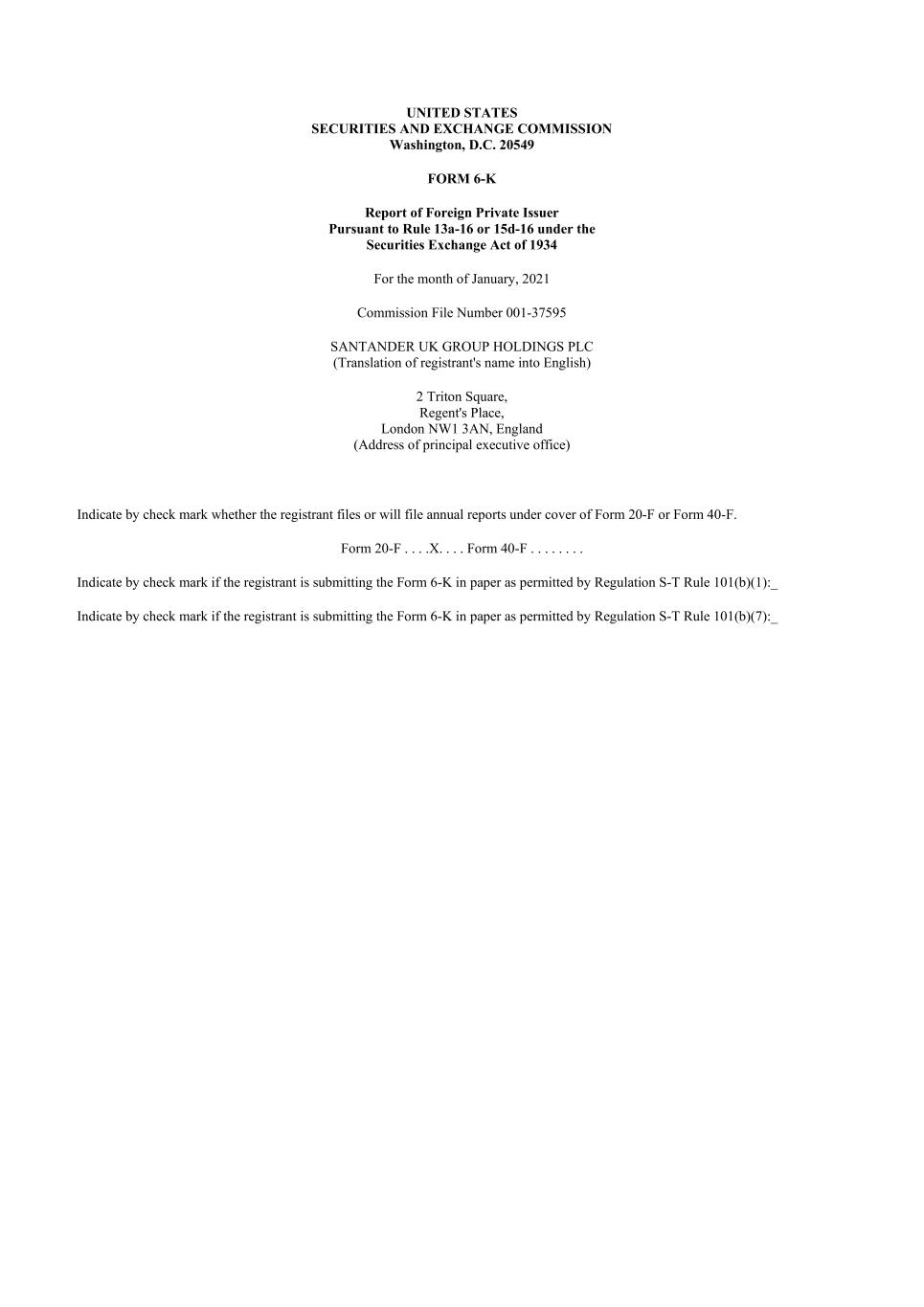
UNITED STATES SECURITIES AND EXCHANGE COMMISSION Washington, D.C. 20549 FORM 6-K Report of Foreign Private Issuer Pursuant to Rule 13a-16 or 15d-16 under the Securities Exchange Act of 1934 For the month of January, 2021 Commission File Number 001-37595 SANTANDER UK GROUP HOLDINGS PLC (Translation of registrant's name into English) 2 Triton Square, Regent's Place, London NW1 3AN, England (Address of principal executive office) Indicate by check mark whether the registrant files or will file annual reports under cover of Form 20-F or Form 40-F. Form 20-F . . . .X. . . . Form 40-F . . . . . . . . Indicate by check mark if the registrant is submitting the Form 6-K in paper as permitted by Regulation S-T Rule 101(b)(1):_ Indicate by check mark if the registrant is submitting the Form 6-K in paper as permitted by Regulation S-T Rule 101(b)(7):_
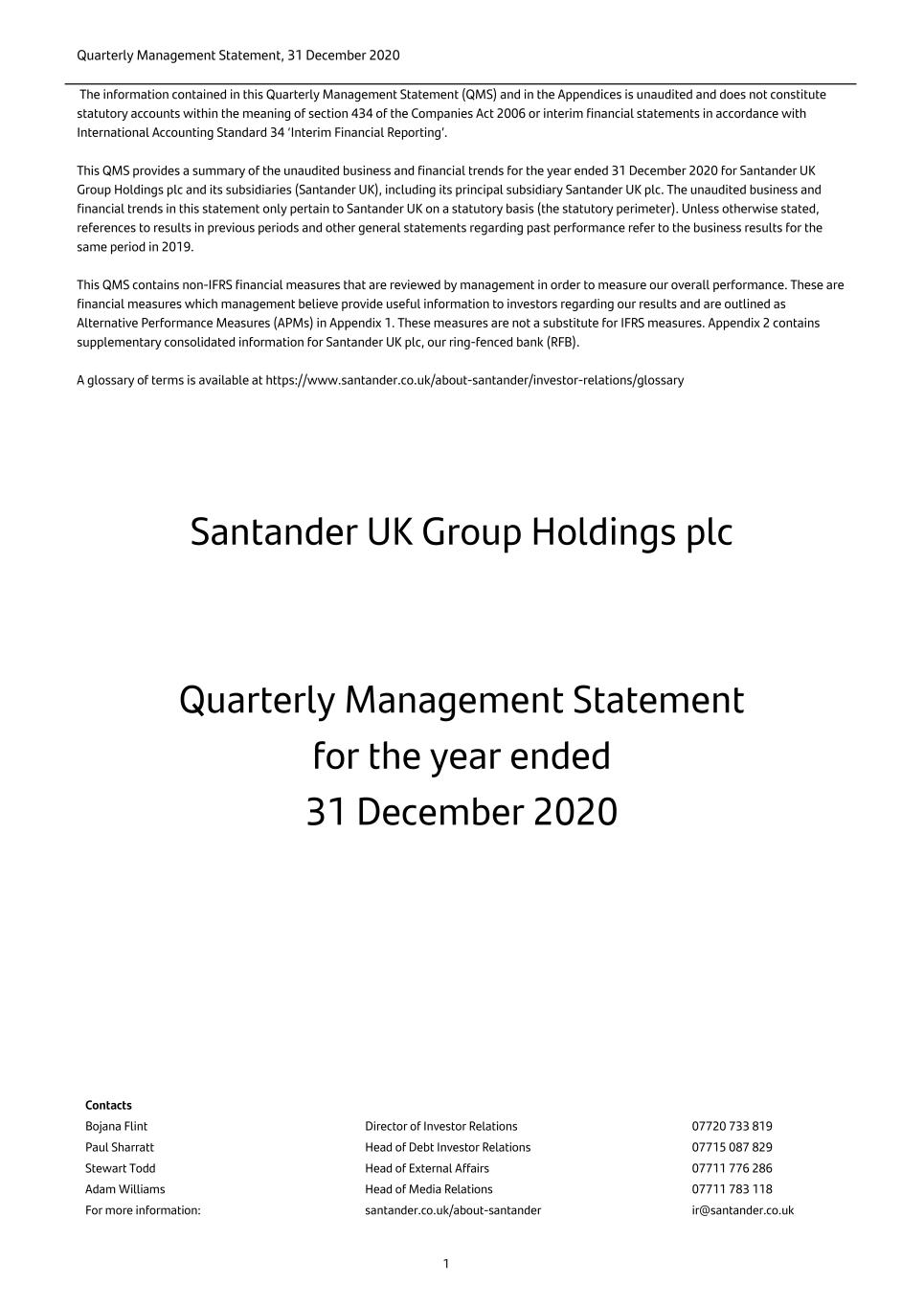
Quarterly Management Statement, 31 December 2020 1 The information contained in this Quarterly Management Statement (QMS) and in the Appendices is unaudited and does not constitute statutory accounts within the meaning of section 434 of the Companies Act 2006 or interim financial statements in accordance with International Accounting Standard 34 ‘Interim Financial Reporting’. This QMS provides a summary of the unaudited business and financial trends for the year ended 31 December 2020 for Santander UK Group Holdings plc and its subsidiaries (Santander UK), including its principal subsidiary Santander UK plc. The unaudited business and financial trends in this statement only pertain to Santander UK on a statutory basis (the statutory perimeter). Unless otherwise stated, references to results in previous periods and other general statements regarding past performance refer to the business results for the same period in 2019. This QMS contains non-IFRS financial measures that are reviewed by management in order to measure our overall performance. These are financial measures which management believe provide useful information to investors regarding our results and are outlined as Alternative Performance Measures (APMs) in Appendix 1. These measures are not a substitute for IFRS measures. Appendix 2 contains supplementary consolidated information for Santander UK plc, our ring-fenced bank (RFB). A glossary of terms is available at https://www.santander.co.uk/about-santander/investor-relations/glossary Santander UK Group Holdings plc Quarterly Management Statement for the year ended 31 December 2020 Contacts Bojana Flint Director of Investor Relations 07720 733 819 Paul Sharratt Head of Debt Investor Relations 07715 087 829 Stewart Todd Head of External Affairs 07711 776 286 Adam Williams Head of Media Relations 07711 783 118 For more information: santander.co.uk/about-santander ir@santander.co.uk

Quarterly Management Statement, 31 December 2020 2 Nathan Bostock, Chief Executive Officer, commented: “Our customers, colleagues and communities have faced an incredibly challenging year, and our unwavering focus has been on providing vital support when it was needed.” “Thanks to the extraordinary hard work and commitment of my colleagues, we have been able to continue providing essential banking services throughout the pandemic, alongside tailored help to customers who are facing challenges. I am proud to say we have lent £4.6bn to our business customers through the Government-backed lending schemes and provided customers with over 373,000 payment holidays.” “Although Covid-19 materially impacted our results, the decisive actions we have taken have helped to deliver a very resilient performance despite the difficult environment. We have achieved strong lending growth, particularly in mortgages, grown customer deposits, delivered further efficiency savings and a notable improvement in income in the second half of the year.” “With vaccines being rolled out at pace and the ratification of the Brexit trade agreement, we are well positioned to support the UK’s economic recovery over the coming years and deliver on our purpose to help people and businesses prosper.” . Covid-19 impact on our 2020 results partially mitigated by strong net interest income improvement in H220 Statutory PBT of £552m, down 44% YoY, adjusted PBT 1 of £710m, down 45%, return on ordinary shareholders’ equity of 2.9% (2019: 4.9%) and adjusted RoTE 1 of 4.3% (2019: 7.8%). £448m Covid-19 related provision for expected credit losses in 2020, although credit impairment charges were down 43% QoQ. Income down 5% YoY, with ongoing pressure on fees and low rates. Income up for last two quarters following management actions. Banking NIM up 1bp YoY and Adjusted Banking NIM2 down 1bp YoY. Deposit repricing adversely impacted customer satisfaction and loyalty metrics. Operating expenses down 2% YoY, adjusted operating expenses 1 down 5%, through realised efficiency savings. Other provisions and charges down 38% YoY to £274m, with the absence of PPI and lower transformation restructuring charges. Supporting our customers, people and communities remains our top priority Provided over 373k payment holidays and £4.6bn of government backed business loans to support customers through the pandemic. Strong net mortgage growth of £4.4bn, with a rebound in application volumes following the Q220 housing market closure. Enabled 85% of our people to work remotely and launched a colleague wellbeing hub which has been used over 95k times. Donated £7.5m for Covid-19 research, hardship funds and community activities and £300k to UK vaccine development programmes. With strong capital and liquidity and a prudent approach to risk, we are well positioned to support the UK’s economic recovery Prime retail mortgage book (80% of total loans) with an average LTV of 42%. Limited unsecured retail exposure (c2% of total loans). CET1 capital ratio of 15.2% (2019: 14.3%) and UK leverage ratio of 5.1% (2019: 4.7%), significantly above regulatory requirements. LCR of 150% (2019: 142%); with very strong customer deposit growth of £13.9bn (2019: £5.7bn). Maintaining focus on our multi-year transformation programme Invested £332m and realised £244m of savings since commencing the programme in 2019 with a strategic focus on improving returns while becoming more agile, efficient and responsive to the needs of our customers. Applying learnings from the Covid-19 crisis, including a reassessment of our business operations and adapting to the demands of our customers and employees by becoming more digital and being able to offer more flexibility to our people. Income statement highlights 2020 £m 2019 £m Operating income 3,958 4,170 Operating expenses before credit impairment losses, provisions and charges (2,487) (2,526) Credit impairment losses (645) (220) Provisions for other liabilities and charges (274) (443) Profit before tax 552 981 Adjusted profit before tax 1 710 1,300 Balance sheet and capital highlights 31.12.20 31.12.19 £bn £bn Customer loans 210.4 205.3 - of which retail mortgages 169.8 165.4 - of which corporates 27.5 26.4 Customer deposits 191.7 177.8 CET1 capital ratio 15.2% 14.3% UK leverage ratio 5.1% 4.7% 1. Non-IFRS measure. The financial results and adjusted RoTE were impacted by a number of specific income, expenses and charges with an aggregate impact on profit before tax of £158m in 2020 and £319m in 2019. See Appendix 1 for details of APMs and reconciliation to the nearest IFRS measure. 2. Non-IFRS measure. Adjusted Banking NIM calculated using adjusted net interest income. See Appendix 1 for details and reconciliation to the nearest IFRS measure.

Quarterly Management Statement, 31 December 2020 3 Delivering on our strategic priorities Our strategic priorities are aligned to Banco Santander’s One Europe strategy, with a focus on customer loyalty, simplification, improved efficiency and sustainable growth, while aiming to be the best bank for all our stakeholders. We are transforming the business for success in order to meet changing customer needs and deliver on our purpose to help people and businesses prosper. Customers remain at the heart of what we do and a key part of our strategy although we have seen some deterioration in our KPIs for loyal customers and retail net promoter score this year. This followed 1I2I3 Current Account repricing actions linked to base rate reductions. However, balances have improved over the year and overall account numbers have remained broadly stable. Further information on our strategy and how we measure success will be provided in our 2020 Annual Report and ESG Supplement due to be published in March 2021. See Appendix 4 for KPI definitions. 1. Grow customer loyalty by providing an outstanding customer experience 31.12.20 31.12.19 Loyal customers (million) 4.4 4.6 Digital customers (million) 6.3 5.8 Retail net promoter score (NPS) 8th 4th Business and corporate NPS 1st 1st 2. Simplify and digitise the business for improved efficiency and returns Adjusted RoTE 1 See below See below Adjusted cost-to-income ratio 1 See below See below 3. Invest in our people and ensure they have the skills and knowledge to thrive Top 10 company to work for Medium-term aim 4. Further embed sustainability across our business Financially empowered people 500,000 248,100 Return on ordinary shareholders’ equity was 2.9% (2019: 4.9%) and Adjusted RoTE 1 was 4.3% (2019: 7.8%). Cost-to-income ratio (CIR) was 63% (2019: 61%) and Adjusted cost-to-income ratio 1 was 59% (2019: 59%). 2021 operating environment With further lockdown restrictions imposed in Jan21, the UK economic environment remains challenging. Our base case assumes some form of restrictions are still in place in Q221 and growth recovers over the latter part of the year as the vaccine rollout continues and businesses become more familiar with the new EU trading environment. With the pace of future recovery closely linked to the vaccine rollout, we remain cautious in our outlook. We anticipate mortgage market lending growth of c2%, with house prices falling c2%. The corporate borrowing market remains more unpredictable and despite downside risk is expected to grow by c2%. 2021 outlook We expect our net mortgage lending to be in line with market growth, as we focus on quality customer service, retention and our comprehensive proposition for first-time buyers. We expect Banking NIM to remain broadly in line with the Q420 rate, predicated on stable mortgage margins, 1I2I3 Current Account repricing announced in Jan21 and no change to the Bank of England base rate. As we continue our transformation programme, we expect to deliver further cost savings and for operating expenses to continue to trend downward. Credit impairment charges are expected to be lower, driven by UK economic recovery in the latter part of the year as outlined in our base case scenario. Since 31 December 2020, trends evident in the business operating results have not changed significantly. 1. Non-IFRS measure. Adjusted RoTE and Adjusted cost-to-income ratio were impacted by a number of specific income, expenses and charges with an aggregate impact on profit before tax of £138m in 2020 and £319m in 2019. See Appendix 1 for details and reconciliation to the nearest IFRS measure.
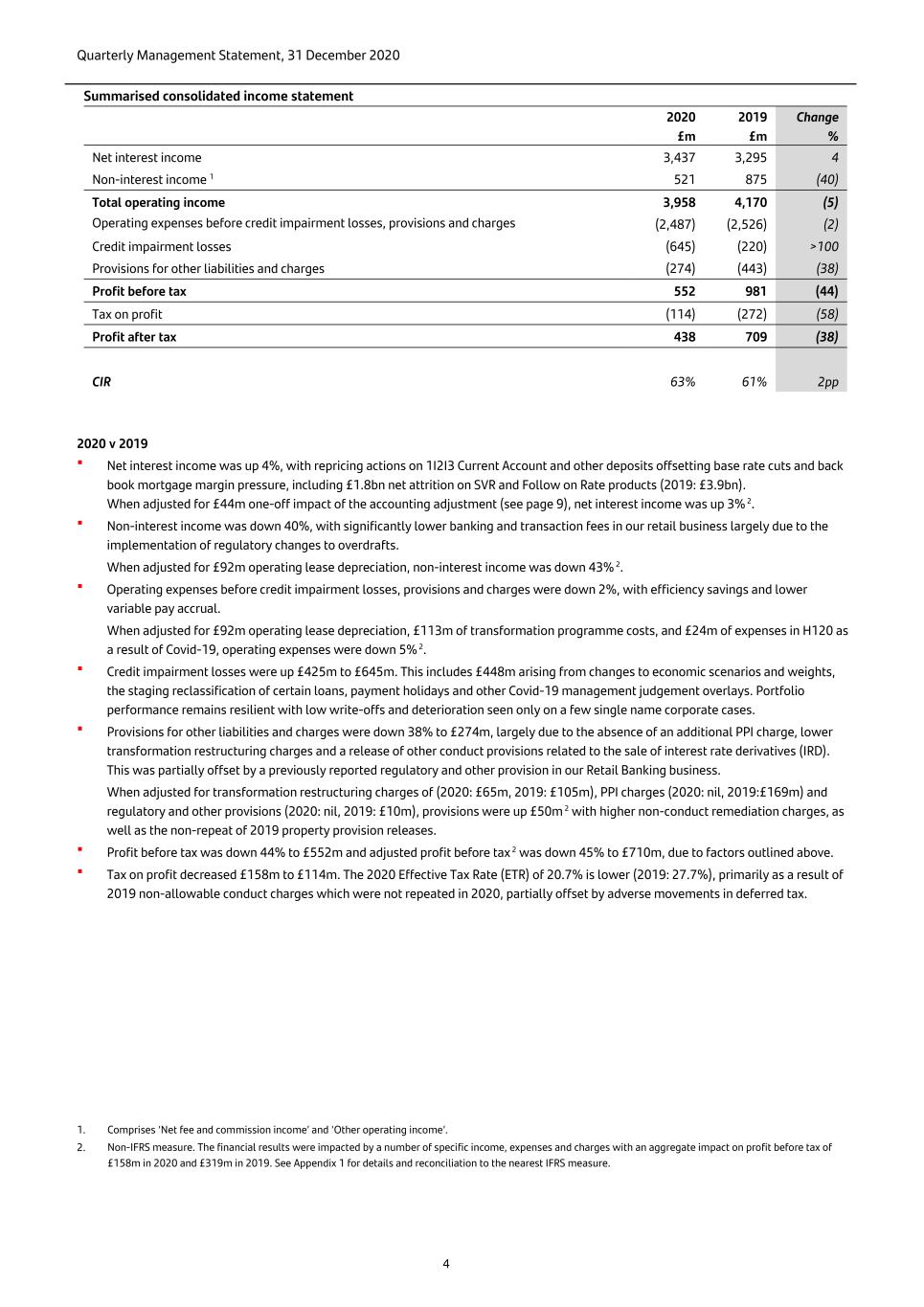
Quarterly Management Statement, 31 December 2020 4 Summarised consolidated income statement 2020 2019 Change £m £m % Net interest income 3,437 3,295 4 Non-interest income 1 521 875 (40) Total operating income 3,958 4,170 (5) Operating expenses before credit impairment losses, provisions and charges (2,487) (2,526) (2) Credit impairment losses (645) (220) >100 Provisions for other liabilities and charges (274) (443) (38) Profit before tax 552 981 (44) Tax on profit (114) (272) (58) Profit after tax 438 709 (38) CIR 63% 61% 2pp 2020 v 2019 Net interest income was up 4%, with repricing actions on 1I2I3 Current Account and other deposits offsetting base rate cuts and back book mortgage margin pressure, including £1.8bn net attrition on SVR and Follow on Rate products (2019: £3.9bn). When adjusted for £44m one-off impact of the accounting adjustment (see page 9), net interest income was up 3% 2. Non-interest income was down 40%, with significantly lower banking and transaction fees in our retail business largely due to the implementation of regulatory changes to overdrafts. When adjusted for £92m operating lease depreciation, non-interest income was down 43% 2. Operating expenses before credit impairment losses, provisions and charges were down 2%, with efficiency savings and lower variable pay accrual. When adjusted for £92m operating lease depreciation, £113m of transformation programme costs, and £24m of expenses in H120 as a result of Covid-19, operating expenses were down 5% 2. Credit impairment losses were up £425m to £645m. This includes £448m arising from changes to economic scenarios and weights, the staging reclassification of certain loans, payment holidays and other Covid-19 management judgement overlays. Portfolio performance remains resilient with low write-offs and deterioration seen only on a few single name corporate cases. Provisions for other liabilities and charges were down 38% to £274m, largely due to the absence of an additional PPI charge, lower transformation restructuring charges and a release of other conduct provisions related to the sale of interest rate derivatives (IRD). This was partially offset by a previously reported regulatory and other provision in our Retail Banking business. When adjusted for transformation restructuring charges of (2020: £65m, 2019: £105m), PPI charges (2020: nil, 2019:£169m) and regulatory and other provisions (2020: nil, 2019: £10m), provisions were up £50m 2 with higher non-conduct remediation charges, as well as the non-repeat of 2019 property provision releases. Profit before tax was down 44% to £552m and adjusted profit before tax 2 was down 45% to £710m, due to factors outlined above. Tax on profit decreased £158m to £114m. The 2020 Effective Tax Rate (ETR) of 20.7% is lower (2019: 27.7%), primarily as a result of 2019 non-allowable conduct charges which were not repeated in 2020, partially offset by adverse movements in deferred tax. 1. Comprises ‘Net fee and commission income’ and ‘Other operating income’. 2. Non-IFRS measure. The financial results were impacted by a number of specific income, expenses and charges with an aggregate impact on profit before tax of £158m in 2020 and £319m in 2019. See Appendix 1 for details and reconciliation to the nearest IFRS measure.

Quarterly Management Statement, 31 December 2020 5 Summarised income statement Q420 Q320 Change £m £m % Net interest income 1,014 881 15 Non-interest income 1 71 144 (51) Total operating income 1,085 1,025 6 Operating expenses before credit impairment losses, provisions and charges (619) (611) 1 Credit impairment losses (98) (171) (43) Provisions for other liabilities and charges (135) (71) 90 Profit before tax 233 172 35 Tax on profit (37) (42) (12) Profit after tax 196 130 51 CIR 57% 60% -3pp Q420 v Q320 Quarter on quarter variances largely followed the trends outlined for 2020 versus 2019, with the following notable exceptions: Operating expenses increased £8m to £619m due to increased transformation programme spend. Credit impairment losses decreased 43% largely due to lower corporate staging charges taken in Q420. Provisions for other liabilities and charges increased £64m to £135m, mainly due to the £74m UK Bank Levy charged annually in Q4. Summarised balance sheet 31.12.20 31.12.19 £bn £bn Customer loans 210.4 205.3 Other assets 88.7 83.2 Total assets 299.1 288.5 Customer deposits 191.7 177.8 Total wholesale funding 63.2 65.3 Other liabilities 28.0 29.1 Total liabilities 282.9 272.2 Shareholders’ equity 15.8 15.9 Non-controlling interest 0.4 0.4 Total liabilities and equity 299.1 288.5 Customer loans increased £5.1bn, with £4.4bn increase in mortgages due to pent up demand from the lockdown period and the temporary reduced rates of stamp duty. In addition, consumer (auto) finance increased by £0.3bn, and unsecured retail lending decreased by £0.7bn due to lower consumer spending during lockdown. Corporate loans increased £1.1bn, driven by our participation in the government lending schemes (£4.6bn), partially offset by lower investment appetite reducing borrowing requirements. Customer deposits increased £13.9bn, of which £7.6bn was corporate and business banking customers building up their cash reserves and £6.7bn related to retail customers increasing current account balances through reduced spending. 1. Comprises ‘Net fee and commission income’ and ‘Other operating income’.

Quarterly Management Statement, 31 December 2020 6 Credit performance – impact of economic scenarios and sectoral and payment holiday review Our 2020 results include £448m of impairment charges arising from changes to economic scenarios and weights and the staging reclassification of certain loans following an in-depth sectoral and payment holiday review, explained in more detail below. Customer loans Gross Loan loss 31 December 2020 Total Stage 1 Stage 2 Stage 3 write-offs allowances £bn £bn £bn £bn £m £m Retail Banking: 186.5 173.2 11.4 1.9 180 706 - of which mortgages 169.8 157.6 10.4 1.8 14 280 - of which business banking 3.9 3.9 - - 12 9 - of which consumer (auto) finance 8.0 7.6 0.4 - 25 118 - of which other unsecured lending 4.8 4.1 0.6 0.1 129 299 Corporate & Commercial Banking 17.6 11.1 5.5 1.0 51 603 Corporate & Investment Banking 2.8 2.6 0.2 - 22 33 Corporate Centre 3.5 3.5 - - - 35 210.4 190.4 17.1 2.9 253 1,377 Undrawn balances 41.8 1.3 0.1 Stage 1, Stage 2 and Stage 31 ratios % 90.49 8.12 1.42 Customer loans Gross Loan loss 31 December 2019 Total Stage 1 Stage 2 Stage 3 write-offs allowances £bn £bn £bn £bn £m £m Retail Banking: 178.8 167.6 9.3 1.9 196 549 - of which mortgages 165.4 155.5 8.2 1.7 14 218 - of which business banking 0.2 0.2 - - 14 9 - of which consumer (auto) finance 7.7 7.0 0.6 0.1 34 88 - of which other unsecured lending 5.5 4.9 0.5 0.1 134 234 Corporate & Commercial Banking 18.4 15.9 2.1 0.4 53 262 Corporate & Investment Banking 4.0 3.8 0.2 - - 50 Corporate Centre 4.1 4.0 0.1 - - 2 205.3 191.3 11.7 2.3 249 863 Undrawn balances 40.9 0.7 0.1 Stage 1, Stage 2 and Stage 31 ratios % 93.20% 5.69% 1.15% We made significant adjustments to our economic assumptions and scenario weightings during 2020 to reflect the emerging impact of the Covid-19 crisis. Our five economic scenarios have been updated for Q420 (outlined on the next page) and weighted further to the downside, to reflect the expected longer path to recovery for the UK. The 2020 impact was an ECL charge of £164m (9M20: £150m), with an increase in Q420 due to the weighting downgrade as a consequence of the Jan21 national lockdown, which was partially offset by higher house prices and a delayed peak in unemployment. We have reclassified the staging of a number of corporate loans based on a review of the sectors and lending most at risk due to Covid-19, while also considering those customers who have been granted some form of concession. Furthermore, we have provided for unexpected large single name exposures defaulting due to a risk which could emerge as a result of the Covid-19 crisis. The 2020 impact was an impairment charge of £212m, up from £172m in 9M20. To support our customers, we have offered payment holidays on a range of products, most of which were taken by customers who were up to date with their repayments. The granting of a payment holiday on its own was not considered to be a Significant Increase in Credit Risk (SICR) event, nor was it considered a default under regulatory definitions, but we provided for potentially higher arrears as a result. In Q420 we reviewed the ECL provision and loans that had taken payment holidays and decreased ECL by £11m to £27m (9M20: £38m). See Appendix 3 for more on payment holidays. We made other Covid-19 management judgement overlays, predominantly relating to mortgage and unsecured personal loan model risk refinement, including delay in repossessions, which increased ECL by £18m in Q420 to £45m (9M20: £29m). 1. Stage3 ratio= (Stage3 drawn + Stage3 undrawn assets)/(total drawn assets + Stage3 undrawn assets).
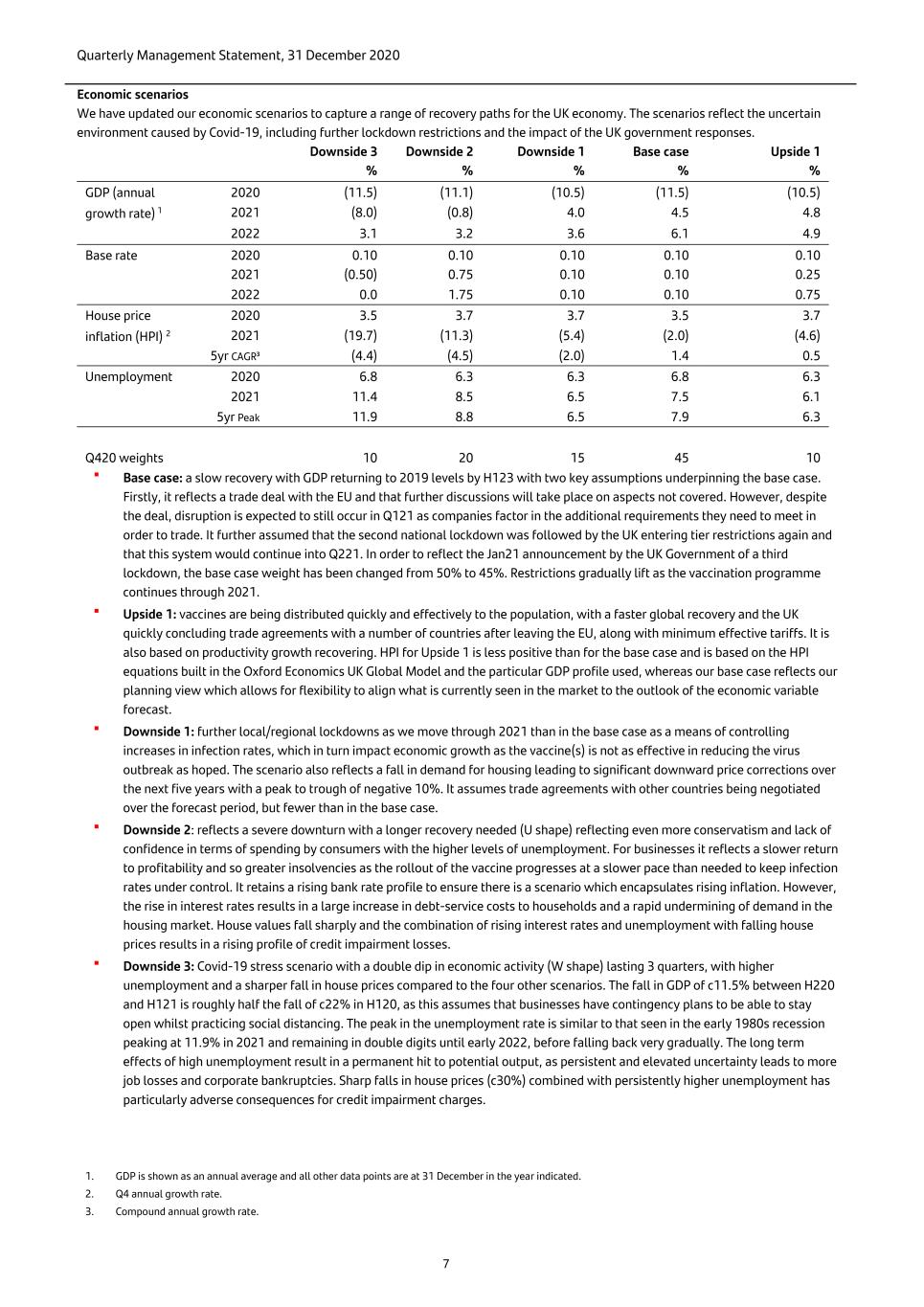
Quarterly Management Statement, 31 December 2020 7 Economic scenarios We have updated our economic scenarios to capture a range of recovery paths for the UK economy. The scenarios reflect the uncertain environment caused by Covid-19, including further lockdown restrictions and the impact of the UK government responses. Downside 3 % Downside 2 % Downside 1 % Base case % Upside 1 % GDP (annual 2020 (11.5) (11.1) (10.5) (11.5) (10.5) growth rate) 1 2021 (8.0) (0.8) 4.0 4.5 4.8 2022 3.1 3.2 3.6 6.1 4.9 Base rate 2020 0.10 0.10 0.10 0.10 0.10 2021 (0.50) 0.75 0.10 0.10 0.25 2022 0.0 1.75 0.10 0.10 0.75 House price 2020 3.5 3.7 3.7 3.5 3.7 inflation (HPI) 2 2021 (19.7) (11.3) (5.4) (2.0) (4.6) 5yr CAGR3 (4.4) (4.5) (2.0) 1.4 0.5 Unemployment 2020 6.8 6.3 6.3 6.8 6.3 2021 11.4 8.5 6.5 7.5 6.1 5yr Peak 11.9 8.8 6.5 7.9 6.3 Q420 weights 10 20 15 45 10 Base case: a slow recovery with GDP returning to 2019 levels by H123 with two key assumptions underpinning the base case. Firstly, it reflects a trade deal with the EU and that further discussions will take place on aspects not covered. However, despite the deal, disruption is expected to still occur in Q121 as companies factor in the additional requirements they need to meet in order to trade. It further assumed that the second national lockdown was followed by the UK entering tier restrictions again and that this system would continue into Q221. In order to reflect the Jan21 announcement by the UK Government of a third lockdown, the base case weight has been changed from 50% to 45%. Restrictions gradually lift as the vaccination programme continues through 2021. Upside 1: vaccines are being distributed quickly and effectively to the population, with a faster global recovery and the UK quickly concluding trade agreements with a number of countries after leaving the EU, along with minimum effective tariffs. It is also based on productivity growth recovering. HPI for Upside 1 is less positive than for the base case and is based on the HPI equations built in the Oxford Economics UK Global Model and the particular GDP profile used, whereas our base case reflects our planning view which allows for flexibility to align what is currently seen in the market to the outlook of the economic variable forecast. Downside 1: further local/regional lockdowns as we move through 2021 than in the base case as a means of controlling increases in infection rates, which in turn impact economic growth as the vaccine(s) is not as effective in reducing the virus outbreak as hoped. The scenario also reflects a fall in demand for housing leading to significant downward price corrections over the next five years with a peak to trough of negative 10%. It assumes trade agreements with other countries being negotiated over the forecast period, but fewer than in the base case. Downside 2: reflects a severe downturn with a longer recovery needed (U shape) reflecting even more conservatism and lack of confidence in terms of spending by consumers with the higher levels of unemployment. For businesses it reflects a slower return to profitability and so greater insolvencies as the rollout of the vaccine progresses at a slower pace than needed to keep infection rates under control. It retains a rising bank rate profile to ensure there is a scenario which encapsulates rising inflation. However, the rise in interest rates results in a large increase in debt-service costs to households and a rapid undermining of demand in the housing market. House values fall sharply and the combination of rising interest rates and unemployment with falling house prices results in a rising profile of credit impairment losses. Downside 3: Covid-19 stress scenario with a double dip in economic activity (W shape) lasting 3 quarters, with higher unemployment and a sharper fall in house prices compared to the four other scenarios. The fall in GDP of c11.5% between H220 and H121 is roughly half the fall of c22% in H120, as this assumes that businesses have contingency plans to be able to stay open whilst practicing social distancing. The peak in the unemployment rate is similar to that seen in the early 1980s recession peaking at 11.9% in 2021 and remaining in double digits until early 2022, before falling back very gradually. The long term effects of high unemployment result in a permanent hit to potential output, as persistent and elevated uncertainty leads to more job losses and corporate bankruptcies. Sharp falls in house prices (c30%) combined with persistently higher unemployment has particularly adverse consequences for credit impairment charges. 1. GDP is shown as an annual average and all other data points are at 31 December in the year indicated. 2. Q4 annual growth rate. 3. Compound annual growth rate.
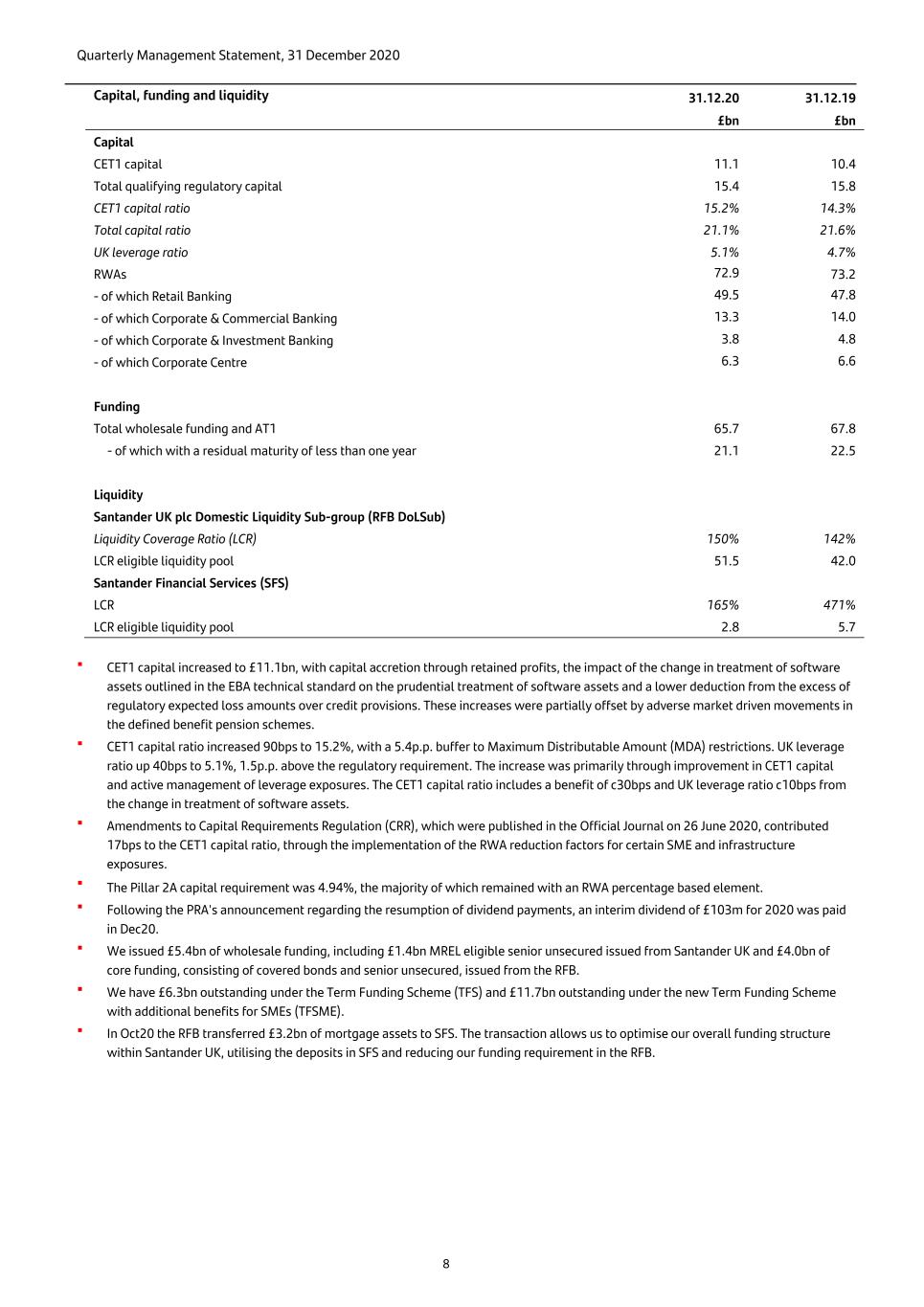
Quarterly Management Statement, 31 December 2020 8 Capital, funding and liquidity 31.12.20 31.12.19 £bn £bn Capital CET1 capital 11.1 10.4 Total qualifying regulatory capital 15.4 15.8 CET1 capital ratio 15.2% 14.3% Total capital ratio 21.1% 21.6% UK leverage ratio 5.1% 4.7% RWAs 72.9 73.2 - of which Retail Banking 49.5 47.8 - of which Corporate & Commercial Banking 13.3 14.0 - of which Corporate & Investment Banking 3.8 4.8 - of which Corporate Centre 6.3 6.6 Funding Total wholesale funding and AT1 65.7 67.8 - of which with a residual maturity of less than one year 21.1 22.5 Liquidity Santander UK plc Domestic Liquidity Sub-group (RFB DoLSub) Liquidity Coverage Ratio (LCR) 150% 142% LCR eligible liquidity pool 51.5 42.0 Santander Financial Services (SFS) LCR 165% 471% LCR eligible liquidity pool 2.8 5.7 CET1 capital increased to £11.1bn, with capital accretion through retained profits, the impact of the change in treatment of software assets outlined in the EBA technical standard on the prudential treatment of software assets and a lower deduction from the excess of regulatory expected loss amounts over credit provisions. These increases were partially offset by adverse market driven movements in the defined benefit pension schemes. CET1 capital ratio increased 90bps to 15.2%, with a 5.4p.p. buffer to Maximum Distributable Amount (MDA) restrictions. UK leverage ratio up 40bps to 5.1%, 1.5p.p. above the regulatory requirement. The increase was primarily through improvement in CET1 capital and active management of leverage exposures. The CET1 capital ratio includes a benefit of c30bps and UK leverage ratio c10bps from the change in treatment of software assets. Amendments to Capital Requirements Regulation (CRR), which were published in the Official Journal on 26 June 2020, contributed 17bps to the CET1 capital ratio, through the implementation of the RWA reduction factors for certain SME and infrastructure exposures. The Pillar 2A capital requirement was 4.94%, the majority of which remained with an RWA percentage based element. Following the PRA's announcement regarding the resumption of dividend payments, an interim dividend of £103m for 2020 was paid in Dec20. We issued £5.4bn of wholesale funding, including £1.4bn MREL eligible senior unsecured issued from Santander UK and £4.0bn of core funding, consisting of covered bonds and senior unsecured, issued from the RFB. We have £6.3bn outstanding under the Term Funding Scheme (TFS) and £11.7bn outstanding under the new Term Funding Scheme with additional benefits for SMEs (TFSME). In Oct20 the RFB transferred £3.2bn of mortgage assets to SFS. The transaction allows us to optimise our overall funding structure within Santander UK, utilising the deposits in SFS and reducing our funding requirement in the RFB.
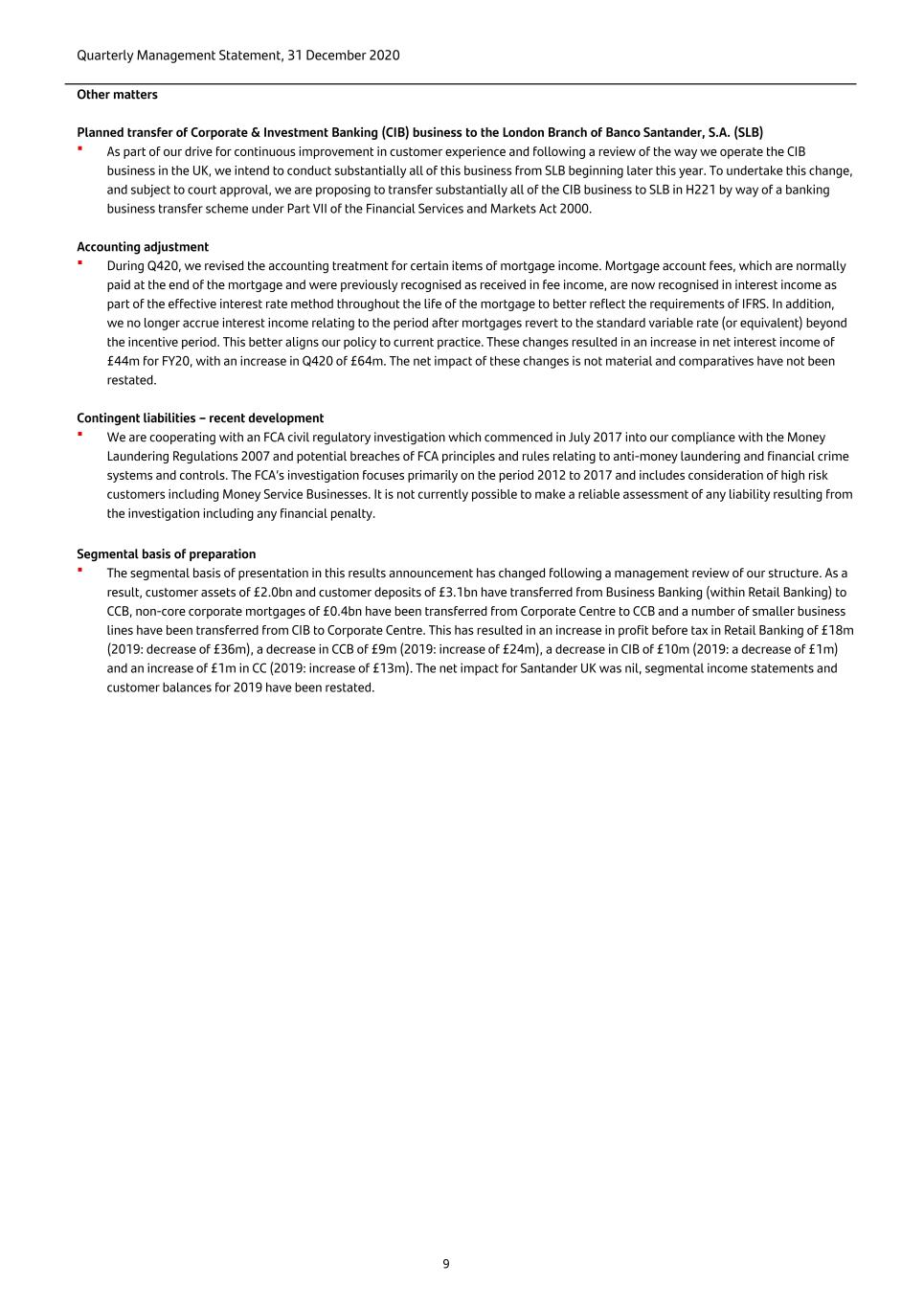
Quarterly Management Statement, 31 December 2020 9 Other matters Planned transfer of Corporate & Investment Banking (CIB) business to the London Branch of Banco Santander, S.A. (SLB) As part of our drive for continuous improvement in customer experience and following a review of the way we operate the CIB business in the UK, we intend to conduct substantially all of this business from SLB beginning later this year. To undertake this change, and subject to court approval, we are proposing to transfer substantially all of the CIB business to SLB in H221 by way of a banking business transfer scheme under Part VII of the Financial Services and Markets Act 2000. Accounting adjustment During Q420, we revised the accounting treatment for certain items of mortgage income. Mortgage account fees, which are normally paid at the end of the mortgage and were previously recognised as received in fee income, are now recognised in interest income as part of the effective interest rate method throughout the life of the mortgage to better reflect the requirements of IFRS. In addition, we no longer accrue interest income relating to the period after mortgages revert to the standard variable rate (or equivalent) beyond the incentive period. This better aligns our policy to current practice. These changes resulted in an increase in net interest income of £44m for FY20, with an increase in Q420 of £64m. The net impact of these changes is not material and comparatives have not been restated. Contingent liabilities – recent development We are cooperating with an FCA civil regulatory investigation which commenced in July 2017 into our compliance with the Money Laundering Regulations 2007 and potential breaches of FCA principles and rules relating to anti-money laundering and financial crime systems and controls. The FCA’s investigation focuses primarily on the period 2012 to 2017 and includes consideration of high risk customers including Money Service Businesses. It is not currently possible to make a reliable assessment of any liability resulting from the investigation including any financial penalty. Segmental basis of preparation The segmental basis of presentation in this results announcement has changed following a management review of our structure. As a result, customer assets of £2.0bn and customer deposits of £3.1bn have transferred from Business Banking (within Retail Banking) to CCB, non-core corporate mortgages of £0.4bn have been transferred from Corporate Centre to CCB and a number of smaller business lines have been transferred from CIB to Corporate Centre. This has resulted in an increase in profit before tax in Retail Banking of £18m (2019: decrease of £36m), a decrease in CCB of £9m (2019: increase of £24m), a decrease in CIB of £10m (2019: a decrease of £1m) and an increase of £1m in CC (2019: increase of £13m). The net impact for Santander UK was nil, segmental income statements and customer balances for 2019 have been restated.

Quarterly Management Statement, 31 December 2020 10 Retail Banking 1 Summary income statement 2020 2019 Change £m £m % Net interest income 3,105 2,827 10 Non-interest income 2 375 691 (46) Operating income 3,480 3,518 (1) Operating expenses before credit impairment losses, provisions and charges (1,913) (1,980) (3) Credit impairment losses (308) (156) 97 Provisions for other liabilities and charges (175) (290) (40) Profit before tax 1,084 1,092 (1) Profit before tax decreased 1%, with an increase in credit impairment charges largely due to Covid-19, partially offset by an increase in net interest income largely due to 1I2I3 Current Account and other deposit repricing. Non-interest income was impacted by reduced banking and transaction fees as a result of regulatory changes to overdrafts. Customer balances 31.12.20 31.12.19 £bn £bn Mortgages 169.8 165.4 Business banking 3.9 0.2 Consumer (auto) finance 8.0 7.7 Other unsecured lending 4.8 5.5 Customer loans 186.5 178.8 Current accounts 75.6 68.7 Savings 57.4 57.2 Business banking accounts 13.4 10.5 Other retail products 5.8 6.3 Customer deposits 152.2 142.7 Corporate & Commercial Banking 1 Summary income statement 2020 2019 Change £m £m % Net interest income 364 422 (14) Non-interest income 2 93 109 (15) Operating income 457 531 (14) Operating expenses before credit impairment losses, provisions and charges (316) (324) (2) Credit impairment losses (294) (45) >100 Provisions for other liabilities and charges (12) (22) (45) (Loss)/profit before tax (165) 140 >100 Loss before tax of £165m, with an increase in credit impairment charges largely due to Covid-19, as well as a small number of single name exposures. Income was impacted by the base rate reductions and lower fees due to lower business activity levels which have been adversely affected by Covid-19. Customer balances 31.12.20 31.12.19 £bn £bn Trading businesses 12.9 13.3 CRE 4.7 5.1 Customer loans 17.6 18.4 Customer deposits 25.0 20.5 1. The segmental basis of presentation in this results announcement has changed following a management review of our structure and segmental income statements and customer balances for 2019 have been restated accordingly. See page 9. 2. Comprises ‘Net fee and commission income’ and ‘Other operating income’.
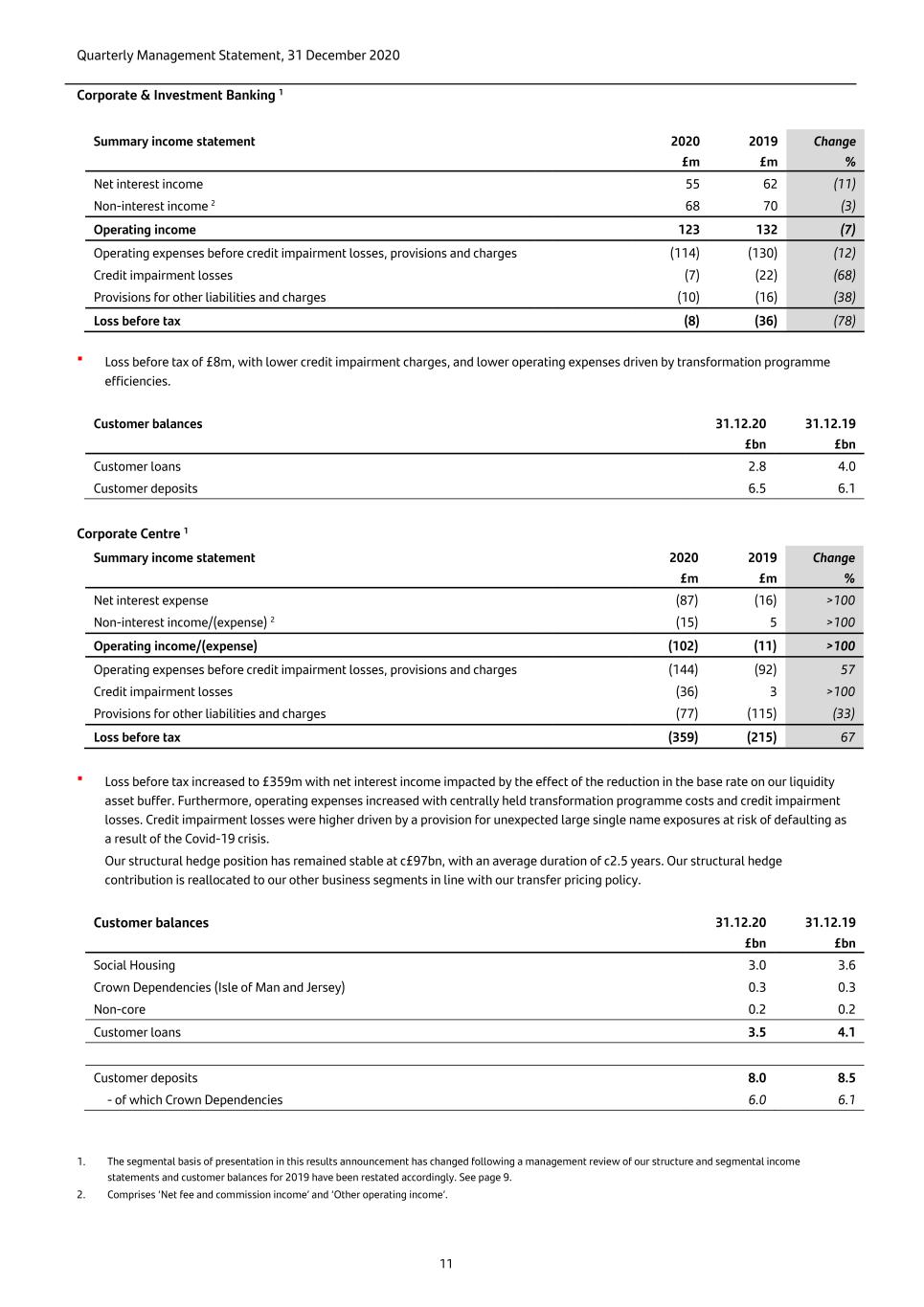
Quarterly Management Statement, 31 December 2020 11 Corporate & Investment Banking 1 Summary income statement 2020 2019 Change £m £m % Net interest income 55 62 (11) Non-interest income 2 68 70 (3) Operating income 123 132 (7) Operating expenses before credit impairment losses, provisions and charges (114) (130) (12) Credit impairment losses (7) (22) (68) Provisions for other liabilities and charges (10) (16) (38) Loss before tax (8) (36) (78) Loss before tax of £8m, with lower credit impairment charges, and lower operating expenses driven by transformation programme efficiencies. Customer balances 31.12.20 31.12.19 £bn £bn Customer loans 2.8 4.0 Customer deposits 6.5 6.1 Corporate Centre 1 Summary income statement 2020 2019 Change £m £m % Net interest expense (87) (16) >100 Non-interest income/(expense) 2 (15) 5 >100 Operating income/(expense) (102) (11) >100 Operating expenses before credit impairment losses, provisions and charges (144) (92) 57 Credit impairment losses (36) 3 >100 Provisions for other liabilities and charges (77) (115) (33) Loss before tax (359) (215) 67 Loss before tax increased to £359m with net interest income impacted by the effect of the reduction in the base rate on our liquidity asset buffer. Furthermore, operating expenses increased with centrally held transformation programme costs and credit impairment losses. Credit impairment losses were higher driven by a provision for unexpected large single name exposures at risk of defaulting as a result of the Covid-19 crisis. Our structural hedge position has remained stable at c£97bn, with an average duration of c2.5 years. Our structural hedge contribution is reallocated to our other business segments in line with our transfer pricing policy. Customer balances 31.12.20 31.12.19 £bn £bn Social Housing 3.0 3.6 Crown Dependencies (Isle of Man and Jersey) 0.3 0.3 Non-core 0.2 0.2 Customer loans 3.5 4.1 Customer deposits 8.0 8.5 - of which Crown Dependencies 6.0 6.1 1. The segmental basis of presentation in this results announcement has changed following a management review of our structure and segmental income statements and customer balances for 2019 have been restated accordingly. See page 9. 2. Comprises ‘Net fee and commission income’ and ‘Other operating income’.

Quarterly Management Statement, 31 December 2020 12 Residential mortgage portfolio analysis Mortgage lending - interest rate profile 31.12.20 31.12.19 £bn % £bn % Fixed rate 136.0 80 128.8 78 Variable rate 21.2 13 22.2 13 Standard Variable Rate 10.7 6 14.1 9 Follow-on-Rate 1.9 1 0.3 - Total mortgages 169.8 100 165.4 100 Mortgage lending - borrower profile 31.12.20 31.12.19 £bn % £bn % Home movers 72.4 42 70.9 43 Re-mortgagers 51.8 31 52.5 32 First-time buyers 34.0 20 32.1 19 BTL 11.6 7 9.9 6 Total mortgages 169.8 100 165.4 100 Mortgage lending - geographical distribution 31.12.20 31.12.19 £bn % £bn % London 42.6 25 41.4 25 Midlands and East Anglia 22.9 13 22.1 13 North 23.1 14 22.7 14 Northern Ireland 3.1 2 3.3 2 Scotland 6.7 4 6.8 4 South East excluding London 53.6 32 51.7 31 South West, Wales and Other 17.8 10 17.4 11 Total mortgages 169.8 100 165.4 100 Mortgage average loan size – new business 2020 2019 £ £ London and South East 284,000 277,000 Rest of UK 166,000 154,000 All UK 218,000 207,000 Mortgage gross lending 2020 2019 £bn £bn Mortgage gross lending 26.3 31.3 - of which first-time buyers 5.4 7.0 - of which BTL 2.6 2.5 Mortgage loan-to-value (LTV) 31.12.20 31.12.19 % % Total new lending 64 65 - of which London 60 61 - of which BTL 65 64 Stock 42 43

Quarterly Management Statement, 31 December 2020 13 Corporate loan portfolio analysis Corporate customer sector split 1 31.12.20 31.12.19 Total Total £bn £bn Social housing 5.8 6.4 Other real estate 4.9 5.5 Wholesale & retail trade 3.7 3.8 Accommodation & food 2.1 1.8 Construction 1.6 1.2 Human health & social work 1.5 1.4 Professional, scientific and technical 1.3 1.0 Administrative & support services 1.3 1.3 Manufacturing 1.0 1.2 Information & communication 0.8 0.5 Transport & storage 0.5 0.5 Electricity & gas 0.6 0.5 Arts, entertainment & recreation 0.4 0.3 Other segments 2.0 1.0 Total corporate loans 27.5 26.4 Of which government lending schemes 4.6 - The corporate loan book is well-diversified with limited sectoral concentration. Social housing is lending and treasury services for UK housing association groups (mainly charitable entities) secured by tenanted UK residential property. We have not had a default, loss or repossession in this portfolio. 1. Total corporate loans consists of £24.3bn of Corporate lending (CCB, CIB and Business Banking) and £3.2bn non-core loans in Corporate Centre (which is mostly Social Housing).

Quarterly Management Statement, 31 December 2020 14 Appendix 1 – Alternative Performance Measures (APMs) In addition to the financial information prepared under IFRS, this Quarterly Management Statement contains non-IFRS financial measures that constitute APMs, as defined in European Securities and Markets Authority (ESMA) guidelines, and non-GAAP financial measures, as defined in (and presented in accordance with) U.S. Securities and Exchange Commission (SEC) rules and guidance. The financial measures contained in this Quarterly Management Statement that qualify as APMs have been calculated using the financial information of the Santander UK group but are not defined or detailed in the applicable financial information framework or under IFRS. We use these APMs when planning, monitoring and evaluating our performance. We consider these APMs to be useful metrics for management and investors to facilitate operating performance comparisons from period to period. Whilst we believe that these APMs are useful in evaluating our business, this information should be considered as supplemental in nature and is not meant as a substitute for IFRS measures. a) Adjusted profit metrics and average customer assets Net interest income, non-interest income, operating expenses before credit impairment losses, provisions and charges, provisions for other liabilities and charges, and profit before tax are all adjusted for items management believe to be significant, to facilitate underlying operating performance comparisons from period to period. Ref. 2020 2019 £m £m Net interest income Reported (i) 3,437 3,295 Adjust for accounting treatment (44) - Adjusted (ii) 3,393 3,295 Non-interest income Reported (iii) 521 875 Adjust for operating lease depreciation (92) (103) Adjust for Vocalink Holdings Limited shareholding - (15) Adjusted (iv) 429 757 Operating expenses before credit impairment losses, provisions and charges Reported (v) (2,487) (2,526) Adjust for transformation 113 50 Adjust for operating lease depreciation 92 103 Adjust for higher IT costs, staff expenses and increased site cleaning as a result of Covid-19 24 - Adjusted (vi) (2,258) (2,373) Provisions for other liabilities and charges Reported (274) (443) Adjust for transformation 65 105 Adjust for PPI - 169 Adjust for regulatory and other - 10 Adjusted (209) (159) Profit before tax Reported 552 981 Specific income, expenses and charges 158 319 Adjusted profit before tax 710 1,300 Average customer assets (vii) 208,525 201,334 Explanations of the above adjustments were disclosed in the 2019 Annual Report on Form 20-F filed with the SEC on 10 March 2020 (2019 Annual Report on Form 20-F) and the 2020 Half Yearly Financial Report filed with the SEC on 13 August 2020 (2020 Half Year Report), except as follows: Accounting adjustment During Q420, we revised the accounting treatment for certain items of mortgage income with an impact on net interest income of £44m for FY20. For more information see page 9. Removal of certain adjusting items During Q420, APMs were reassessed and management concluded that charges relating to regulatory and other conduct matters incurred during the year were no longer sufficiently material to warrant separate adjustments in the context of the results for the full year 2020.
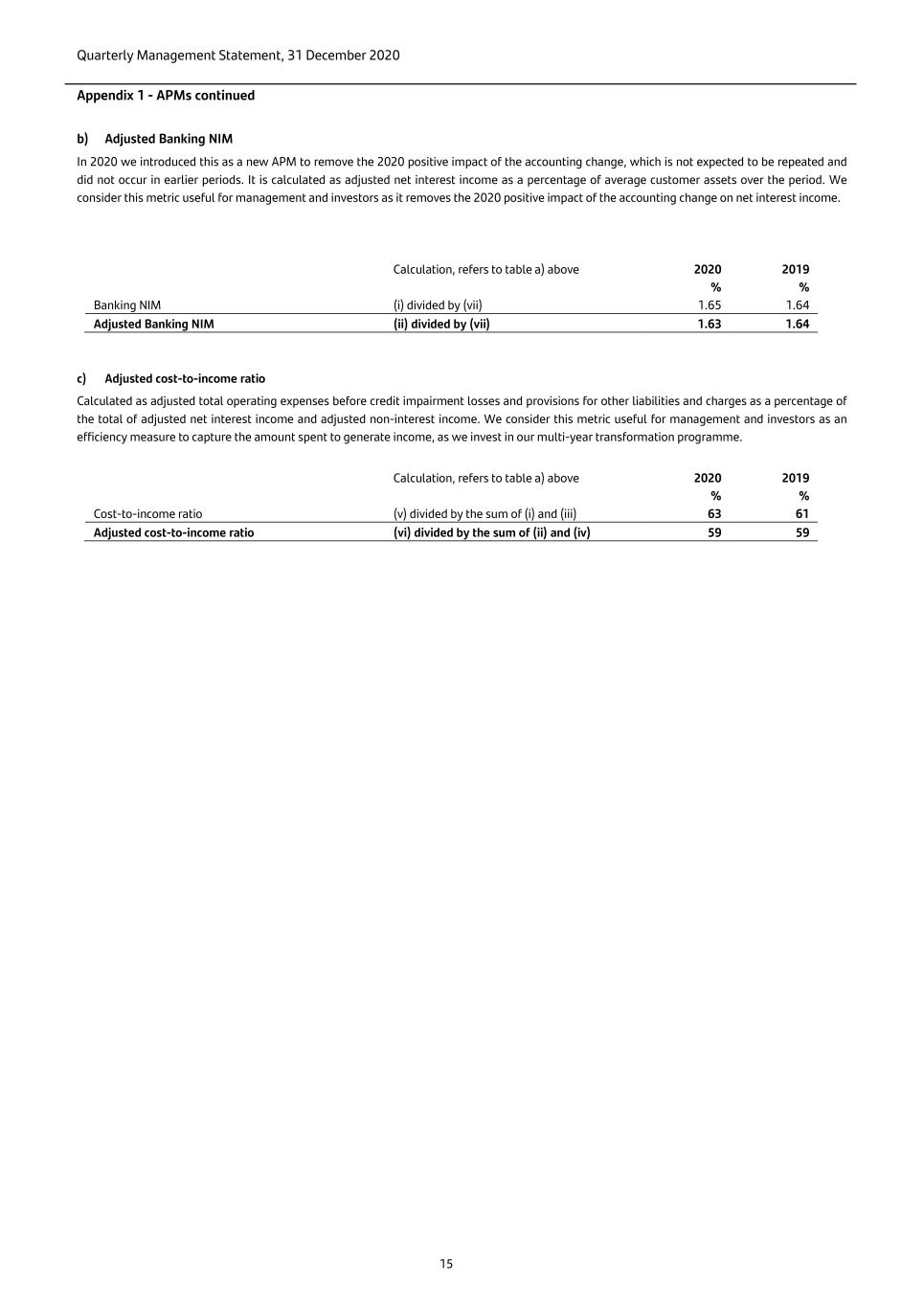
Quarterly Management Statement, 31 December 2020 15 Appendix 1 - APMs continued b) Adjusted Banking NIM In 2020 we introduced this as a new APM to remove the 2020 positive impact of the accounting change, which is not expected to be repeated and did not occur in earlier periods. It is calculated as adjusted net interest income as a percentage of average customer assets over the period. We consider this metric useful for management and investors as it removes the 2020 positive impact of the accounting change on net interest income. Calculation, refers to table a) above 2020 2019 % % Banking NIM (i) divided by (vii) 1.65 1.64 Adjusted Banking NIM (ii) divided by (vii) 1.63 1.64 c) Adjusted cost-to-income ratio Calculated as adjusted total operating expenses before credit impairment losses and provisions for other liabilities and charges as a percentage of the total of adjusted net interest income and adjusted non-interest income. We consider this metric useful for management and investors as an efficiency measure to capture the amount spent to generate income, as we invest in our multi-year transformation programme. Calculation, refers to table a) above 2020 2019 % % Cost-to-income ratio (v) divided by the sum of (i) and (iii) 63 61 Adjusted cost-to-income ratio (vi) divided by the sum of (ii) and (iv) 59 59

Quarterly Management Statement, 31 December 2020 16 Appendix 1 - APMs continued d) Adjusted Return on Tangible Equity (RoTE) Calculated as adjusted profit before tax, less tax on profit, attributable to equity holders of the parent, divided by average shareholders’ equity less non-controlling interests, other equity instruments and average goodwill and other intangible assets. We consider this adjusted measure useful for management and investors as a measure of income generation on shareholder investment, as we focus on improving returns through our multi-year transformation programme. 2020 Specific income, expenses and charges As adjusted £m £m £m Profit after tax for 2020 438 115 553 Less non-controlling interests of annual profit (36) (36) Profit due to equity holders of the parent (A) 402 517 2020 £m Equity adjustments £m As adjusted £m Average shareholders' equity 16,293 Less average Additional Tier 1 (AT1) securities (2,243) Less average non-controlling interests (398) Average ordinary shareholders' equity (B) 13,652 Average goodwill and intangible assets (1,713) Average tangible equity (C) 11,939 29 11,968 Return on ordinary shareholders' equity (A/B) 2.9% - RoTE (A/C) - 4.3% 2019 Specific income, expenses and charges As adjusted £m £m £m Profit after tax for 2019 709 270 979 Less non-controlling interests of annual profit (37) (37) Profit due to equity holders of the parent (A) 672 942 2019 £m Equity adjustments £m As adjusted £m Average shareholders' equity 16,281 Less average Additional Tier 1 (AT1) securities (2,141) Less average non-controlling interests (398) Average ordinary shareholders' equity (B) 13,742 Average goodwill and intangible assets (1,795) Average tangible equity (C) 11,947 68 12,015 Return on ordinary shareholders' equity (A/B) 4.9% - Adjusted RoTE (A/C) - 7.8% Specific income, expenses, charges Details of these items are outlined on the previous page with a total impact on profit before tax of £158m. The tax on these items is c£43m and profit after tax on these items is £115m. Equity adjustments These adjustments are made to reflect the impact of adjustments to profit on average tangible equity.

Quarterly Management Statement, 31 December 2020 17 Appendix 2 - Supplementary consolidated information for Santander UK plc and its controlled entities Santander UK plc is the principal subsidiary of Santander UK Group Holdings plc. Summarised consolidated income statement 2020 2019 £m £m Net interest income 3,443 3,292 Non-interest income 1 532 881 Total operating income 3,975 4,173 Operating expenses before credit impairment losses, provisions and charges (2,452) (2,499) Credit impairment losses (645) (221) Provisions for other liabilities and charges (273) (441) Total operating impairment losses, provisions and charges (918) (662) Profit before tax 605 1,012 Tax on profit (134) (279) Profit after tax for the period 471 733 Summary of segmental balance sheet assets and liabilities 31.12.20 31.12.19 £bn £bn Customer loans Retail Banking 183.4 178.8 Corporate & Commercial Banking 17.6 18.4 Corporate & Investment Banking 2.8 4.0 Corporate Centre 3.2 3.8 Total customer loans 207.0 205.0 Other assets 85.3 76.7 Total assets 292.3 281.7 Customer deposits Retail Banking 152.2 142.7 Corporate & Commercial Banking 25.0 20.5 Corporate & Investment Banking 6.5 6.1 Corporate Centre 2.0 2.4 Total customer deposits 185.7 171.7 Total wholesale funding 63.1 65.2 Other liabilities 27.5 28.7 Total liabilities 276.3 265.6 Shareholders’ equity 15.8 15.9 Non-controlling interests 0.2 0.2 Total liabilities and equity 292.3 281.7 Summarised consolidated capital 31.12.20 31.12.19 £bn £bn Total qualifying regulatory capital 15.2 15.8 Risk-weighted assets (RWAs) 71.9 72.6 Total capital ratio 21.2% 21.7% The information in this Appendix is unaudited and does not constitute statutory accounts within the meaning of section 434 of the Companies Act 2006 or interim financial statements in accordance with International Accounting Standard 34 ‘Interim Financial Reporting’. 1. Comprises ‘Net fee and commission income’ and ‘Other operating income’.
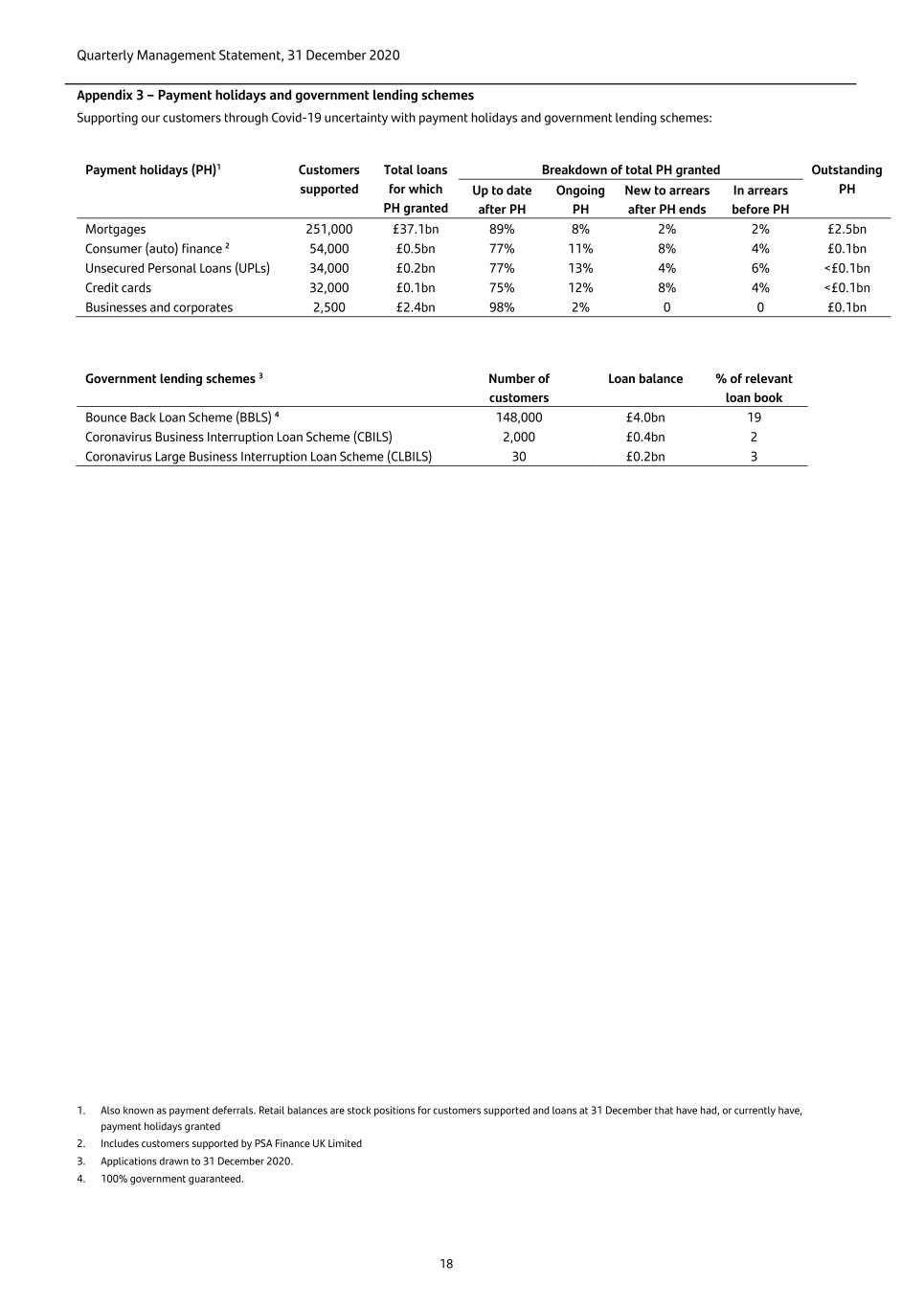
Quarterly Management Statement, 31 December 2020 18 Appendix 3 – Payment holidays and government lending schemes Supporting our customers through Covid-19 uncertainty with payment holidays and government lending schemes: 1. Also known as payment deferrals. Retail balances are stock positions for customers supported and loans at 31 December that have had, or currently have, payment holidays granted 2. Includes customers supported by PSA Finance UK Limited 3. Applications drawn to 31 December 2020. 4. 100% government guaranteed. Payment holidays (PH)1 Customers supported Total loans for which PH granted Breakdown of total PH granted Outstanding PH Up to date after PH Ongoing PH New to arrears after PH ends In arrears before PH Mortgages 251,000 £37.1bn 89% 8% 2% 2% £2.5bn Consumer (auto) finance 2 54,000 £0.5bn 77% 11% 8% 4% £0.1bn Unsecured Personal Loans (UPLs) 34,000 £0.2bn 77% 13% 4% 6% <£0.1bn Credit cards 32,000 £0.1bn 75% 12% 8% 4% <£0.1bn Businesses and corporates 2,500 £2.4bn 98% 2% 0 0 £0.1bn Government lending schemes 3 Number of customers Loan balance % of relevant loan book Bounce Back Loan Scheme (BBLS) 4 148,000 £4.0bn 19 Coronavirus Business Interruption Loan Scheme (CBILS) 2,000 £0.4bn 2 Coronavirus Large Business Interruption Loan Scheme (CLBILS) 30 £0.2bn 3

Quarterly Management Statement, 31 December 2020 19 Appendix 4 – Definitions of KPIs Loyal customers (as a % of active customers) Loyal customers are defined as primary banking current account customers who hold an additional product. Net Promoter Score (NPS) – retail and corporate NPS measures customer experience and predicts business growth. This proven metric provides the core measurement for customer experience management programs and the loyalty of customers to a company. Retail NPS: The Financial Research Survey (NPS) is a monthly personal finance survey of around 5,000 GB consumers aged 16+ prepared by the independent market research agency, Ipsos MORI. The NPS is based on a 11-point scale (%Top2 – %Bottom 7) across mortgages, savings, main current accounts, home insurance, UPLs and credit cards, based on a weighting of those products calculated to reflect the average product distribution across Santander UK and competitor brands. Data shown is for the twelve months ended 31 December 2020, based on 14,413 interviews and compared against twelve months ended data for the period as indicated. Fieldwork is a mixture of online and offline interviews, with the offline methodology changing from face-to-face to telephone in April 2020. Business and corporate NPS: Measured by the MarketVue Business Banking from Savanta. This is an ongoing telephone based survey designed to monitor usage and attitude of UK businesses towards banks. 14,500 structured telephone interviews are conducted each year among businesses of all sizes from new start-ups to large corporates. The data is based upon 9,562 interviews made in twelve months ended 31 December 2020 with businesses turning over from £0 - £500m per annum and are weighted by region and turnover to be representative of businesses in Great Britain. NPS - recommendation score is based on an 11 point scale (%Top 2 - %Bottom 7). The competitor set included in this analysis is Barclays, RBS, HSBC, Lloyds Bank, TSB and NatWest. Digital customers Digital customers reflect the number of customers who have logged onto Retail or Business online banking or mobile app(s) (Retail Mobile includes SanWallet & OnePayFX) at least once in the month. Adjusted RoTE The adjusted profit after tax attributable to equity holders of the parent divided by average shareholders’ equity less non-controlling interests, other equity instruments and average goodwill and intangible assets. See Appendix 1 for details and a reconciliation to the nearest IFRS measure. Adjusted cost to income ratio Adjusted total operating expenses before credit impairment losses and provisions for other liabilities and charges as a percentage of adjusted total operating income. See Appendix 1 for details of adjustments. Top 10 company to work for In line with Banco Santander’s aspiration, we will aim to achieve the accreditation of a Top 10 company to work for, as measured by an industry-wide benchmarking survey, over the medium-term. In the meantime, we will continue to participate in the Top Employers Survey for which we were accredited in 2019 for 2020. We will also consider our participation in a ranking survey (such as Great Places to Work) in 2021, for accreditation in 2022 to check our progress towards our overarching medium-term target. Financially empowered people Number of people, mostly unbanked, underbanked or in a situation of vulnerability who, through our products and services and social investment initiatives are able to get access to the financial system, receive tailored finance and increase their knowledge and resilience through financial education. This metric only considers initiatives and beneficiaries where Santander has gone beyond what is mandated by the regulator, and as it is cumulative it only considers beneficiaries once in the 2019 – 2025 period
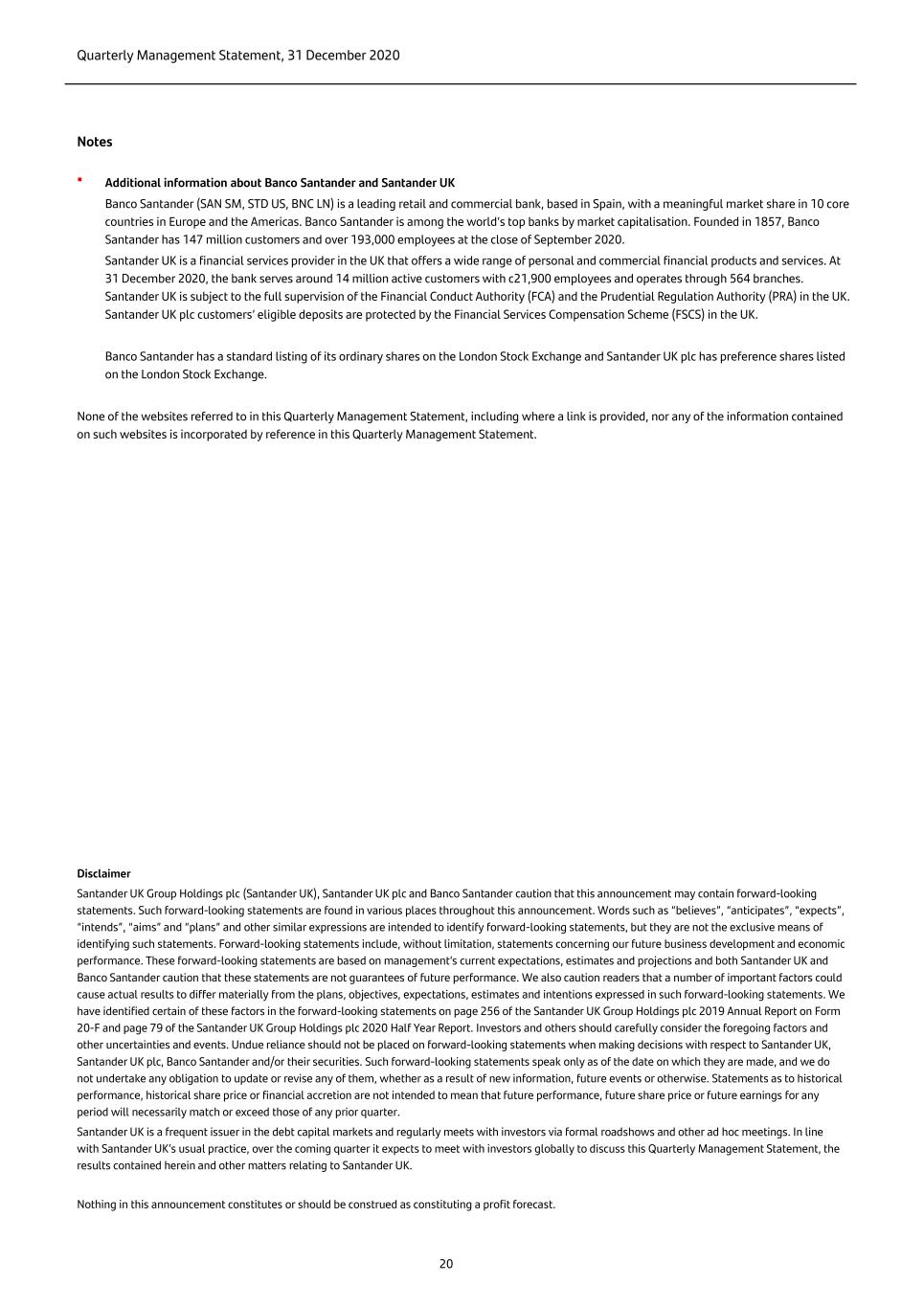
Quarterly Management Statement, 31 December 2020 20 Notes Additional information about Banco Santander and Santander UK Banco Santander (SAN SM, STD US, BNC LN) is a leading retail and commercial bank, based in Spain, with a meaningful market share in 10 core countries in Europe and the Americas. Banco Santander is among the world’s top banks by market capitalisation. Founded in 1857, Banco Santander has 147 million customers and over 193,000 employees at the close of September 2020. Santander UK is a financial services provider in the UK that offers a wide range of personal and commercial financial products and services. At 31 December 2020, the bank serves around 14 million active customers with c21,900 employees and operates through 564 branches. Santander UK is subject to the full supervision of the Financial Conduct Authority (FCA) and the Prudential Regulation Authority (PRA) in the UK. Santander UK plc customers’ eligible deposits are protected by the Financial Services Compensation Scheme (FSCS) in the UK. Banco Santander has a standard listing of its ordinary shares on the London Stock Exchange and Santander UK plc has preference shares listed on the London Stock Exchange. None of the websites referred to in this Quarterly Management Statement, including where a link is provided, nor any of the information contained on such websites is incorporated by reference in this Quarterly Management Statement. Disclaimer Santander UK Group Holdings plc (Santander UK), Santander UK plc and Banco Santander caution that this announcement may contain forward-looking statements. Such forward-looking statements are found in various places throughout this announcement. Words such as “believes”, “anticipates”, “expects”, “intends”, “aims” and “plans” and other similar expressions are intended to identify forward-looking statements, but they are not the exclusive means of identifying such statements. Forward-looking statements include, without limitation, statements concerning our future business development and economic performance. These forward-looking statements are based on management’s current expectations, estimates and projections and both Santander UK and Banco Santander caution that these statements are not guarantees of future performance. We also caution readers that a number of important factors could cause actual results to differ materially from the plans, objectives, expectations, estimates and intentions expressed in such forward-looking statements. We have identified certain of these factors in the forward-looking statements on page 256 of the Santander UK Group Holdings plc 2019 Annual Report on Form 20-F and page 79 of the Santander UK Group Holdings plc 2020 Half Year Report. Investors and others should carefully consider the foregoing factors and other uncertainties and events. Undue reliance should not be placed on forward-looking statements when making decisions with respect to Santander UK, Santander UK plc, Banco Santander and/or their securities. Such forward-looking statements speak only as of the date on which they are made, and we do not undertake any obligation to update or revise any of them, whether as a result of new information, future events or otherwise. Statements as to historical performance, historical share price or financial accretion are not intended to mean that future performance, future share price or future earnings for any period will necessarily match or exceed those of any prior quarter. Santander UK is a frequent issuer in the debt capital markets and regularly meets with investors via formal roadshows and other ad hoc meetings. In line with Santander UK’s usual practice, over the coming quarter it expects to meet with investors globally to discuss this Quarterly Management Statement, the results contained herein and other matters relating to Santander UK. Nothing in this announcement constitutes or should be construed as constituting a profit forecast.

SIGNATURES Pursuant to the requirements of the Securities Exchange Act of 1934, the registrant has duly caused this report to be signed on its behalf by the undersigned, thereunto duly authorized. SANTANDER UK GROUP HOLDINGS PLC Dated: 3 February 2021 By / s / Duke Dayal Duke Dayal Chief Financial Officer





















